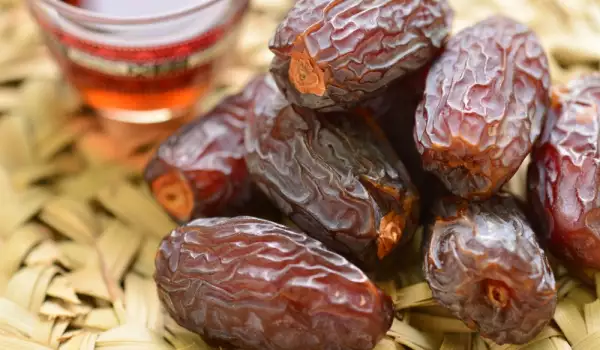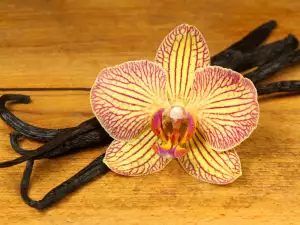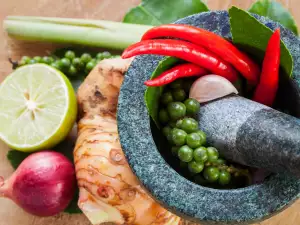The Arabian Peninsula has been closely associated with the subject of spices throughout its history. They were prized throughout the Middle East for their strong aroma and medicinal properties. Long ago, in this corner of the earth, the skill of properly mixing flavors and flavoring each bite of food was developed almost to perfection. Herodotus - the father of history, wrote in the fifth century before the new era about the spices of Arabia and stated that the whole country was flavored with them and exhaled an amazingly sweet scent.
During the centuries of rule of the Roman Empire, there was an insatiable demand for the desire to satisfy gastronomic pretensions and it was centered in the transfer of oriental spices. Slow caravans spun in an irregular thread and crossed the peninsula, their path being clear in advance - to the west, and the transported valuable cargo - important spices such as: black pepper, cardamom, cinnamon, ginger, nard, nutmeg and cloves. Muhammad himself - still a young man and before the Quran was revealed to him, being called to fulfill his covenant mission, accompanied caravans throughout the peninsula to Syria, carrying goods, which were most likely precisely spices.
As Islam spread, countless believers came to Mecca from all corners of the world to perform the Hajj, or pilgrimage, and enriched the peninsula with an extremely diverse culinary tradition. Arab chefs developed a subtle flair in mastering the secret of flavoring, using an explosive emulsion of flavors in each dish to create a rich and subtle flavor that was never overpowering and overwhelming, but richly enhanced the flavor of the food.

In many other areas of the world where the climate is hot, food is over-seasoned. In southern India, Mexico, and parts of Africa, for example, many dishes are served that can literally burn the tongue of the taster, or the unsuspecting tourist, and cause large beads of sweat to run down their foreheads.. Sweating has a cooling effect on the body, of course, and it is generally accepted that this is the purpose of such a forceful experience for the receptors. The spicy taste in Arabic cuisine is not extremely strong and intrusive. While any culinary adventurer can enjoy a satisfying chili, a hearty seasoning of ginger, mustard, or onion, Arabia's flavor is delicious enough to whet an appetite in the heat, but not "spicy" enough to cause a loss of body moisture which is so essential to life in desert lands.
Most towns on the peninsula have well-stocked supermarkets where you can find spices displayed on stands in individual bottles containing colored powders. But it is a far more common occurrence, and a more exciting pastime, to buy various flavoring charms in some small aromatic shops or at some stall in the Sukkah (as the market or commercial part of the city is called). There you will be able to buy whole spices, which are interesting to look at, because by carefully getting to know and smell them, you can reveal which part of the plant is the "source" of fragrance - whether it is the peel or the fruit, or the seeds or the juice. More importantly, the aroma will be stronger and richer, since the volatile essential oils are lost much faster after the spices are grinded.
The seller often offers to grind them on site, or sells a grinded mixture that will assure you it is excellent for specific dishes, such as: rice, pilaf or vegetable stew, but will keep the ingredients of the mystery spice a top secret.
Dates

Dates have always been an important food on the peninsula, where several varieties are grown in the ancient forests surrounding the great oases. They are a flavoring for any meal and a sophisticated addition when serving coffee. The various nuts—almonds, walnuts, peanuts, hazelnuts, and pine nuts—all of which grow in the Middle East region add not only thickness but also flavor to Arabic foods. Familiar spices and herbs such as: cinnamon, cloves, black pepper, cayenne pepper and green peppers, allspice, ginger, mint, parsley, bay leaf, basil, dill, rosemary, garlic and onion are used more often in the dishes of the locals. Some other aromatic Arabic spices that are becoming more popular in the West are also widely used in these lands such as: cumin and coriander. In addition to these globally popular spices that add the unforgettable taste memory of Arabia, there are others that are relatively unknown in the West today.
Sesame

Sesame seeds - pale and tiny seeds of tall grasses grown in many parts of the Middle East - are extremely important to the cuisine of the region. Pressed to extract a high-quality oil or lightly toasted, the seeds add their delicious flavor to a wide variety of baked goods and pastries. The sesame is an extremely beautiful finish and flavor for sweet dates stuffed with almonds. Tahini, a paste made from sesame seeds, is mixed with blended chickpeas, garlic and lemon juice to create one of the favorite dishes of the Middle East, the aromatic hummus. And the seeds mixed with honey are a nutritious and sweet breakfast. Perhaps Ali Baba once commanded the cave Open, Sesame! because the seed pods of the plant (except modern commercial varieties) open suddenly and abruptly when the seeds are ripe.
Cardamom

Cardamom is a key ingredient in that ubiquitous symbol of Arab hospitality - coffee. In the Arabian Peninsula, brewed coffee is usually straw-colored, made from lightly roasted beans, liberally "scented" and flavored with crushed, large pods of green cardamom, and served unsweetened in miniature cups, cup after cup, which ends only when guests' thirst is completely quenched. As it is one of the most expensive spices in the world, a generous sprinkling of cardamom speaks of special respect for the visitor. Coffee, made from dark-roasted beans and usually made with sugar, is drunk occasionally. It is boiled sometimes seasoned with a little grinded cardamom seeds.
The use of this wonderful spice is by no means limited to making coffee. Pleasant, resembling a slight taste of camphor, it combines well with any food or drink - hot or cold. The challenge remains to find an exception to this statement. The seed pods, lightly crushed, are a standard condiment in the traditional Arabic dish kabsa, which is made from lamb with rice. Pods are also a common ingredient in fruit desserts.
Originating from the lands of South India, cardamom has traveled as a trade commodity the short distance to the Arabian Peninsula since ancient times. The plant is part of the ginger family and grows to a height of two meters or more. Cardamom collects its aromatic seeds in pods with curly inflorescences.
Dried lime
Dried lime adds a bright and sharp smell to some varieties of kabsa and to some fish dishes. It can be used whole and removed from the dish before serving, or added as a fine powder. To make your own dried lime, first we need to boil a small and round lime for a few minutes, then we need to leave it to dry in the sun or in a dry and warm place for several weeks, until it darkens and its hollowness stands out after the evaporation of the liquid from its interior.
Mahleb

Mahleb is grinded from the aromatic nut of a type of cherry with a black fruit that adds that distinctive taste and aroma to the sweet braided bread that is popular throughout the Middle East. The seeds of the cherry are grinded into powder and used to make bread and pasta. Mahleb is not only a "bread spice, " but the fruit from which it is made is celebrated for several other uses. The aromatic oil of the cherry tree is used in the production of perfumes.
Mastic
Mastic, spelled mastix in Latin and μαστίχα (mastichḗ - resin) in Greek, is a fragrant resin from the bark of a small evergreen shrub that is "closely related" to the pistachio tree. The shrub's scientific name is Pistacia lentiscus and it is best known nowadays in the West for its use in such commercial products as varnish and paint, and chefs in Arabia continue their centuries-old tradition of seasoning their culinary creations with it and enjoying its unique, fresh resinous aroma and taste. They often add the fragrant spice to meat soups, stews and even puddings. Mastic melts in foods rather than dissolving homogeneously, so it's best to pulverize its clear, light yellow lumps before adding them to food. This spice is one of the many ingredients used in the popular shawarma /doner/, which is a complex emulsion of the flavors of marinated meat and fat that rotates around its axis on a vertical spit placed near a fire.
Nutmeg

Nutmeg is part of a large evergreen tree, "native" of the Spice Islands (Moluccas) in the territory of present-day Indonesia. The fleshy yellow, peach-like fruits of this tree split open when ripe to reveal the nutmeg nestling inside. It is wrapped in a dark brown shell, which is wrapped in a bright red net, which is also used as a spice, called in our country by its English name "mace". Nutmeg has long been at the forefront of many recipes in the Middle East as well as the rest of the world. It is used as a flavoring and medicine, whose medicinal properties are the reason why it is officially classified as a drug, which is why it is currently banned in Saudi Arabia. The admission of large amounts of nutmeg can cause hallucinations followed by a violent headache, and an overdose can even cause death.
Rose and orange water
Rose water and orange blossom water lend their sweet aromas to a variety of prepared dishes - especially puddings and cakes, but also some fruit drinks and salads. They can be used individually or together, depending on the dish and the cook's preference. The essences are distilled from the petals of the flowers with water, using a process developed by the Arabs. The colored waters that are on sale today are usually diluted versions of the original product. Rose water is one of the earliest distilled "products" ever made, and its production was an important commercial industry for the Near East for about 1, 200 years. Rose essence and orange blossom aroma are added to food simply for the pleasure of the aroma they impart and to play playfully with the limits of perception for an appropriate aromatic seasoning.
Sheba
Sheba is a spice also known as "old man's beard" which is a lichen from a tree. It is used in the Arabian Peninsula. Its complexly bitter, metallic flavor is popular in meat and vegetable stews. A small amount of curly and black-silver lichen can add flavor to a large amount of products.
Saffron

Saffron is often used in more elegant rice dishes, both spicy and sweet, it brightens any meal as much with its captivating yellow color as with its undeniable earthy flavor. Chicken and fish are also often flavored with saffron. This aromatic Arabian spice, which is the most expensive in the world, is made from the licorice of the autumn-flowering crocus in the Middle East. It takes 80, 000 flowers to produce 1 kilogram of pure spice. Saffron in the stores today comes mostly from Spain, where it was spread by the Arabs in the eighth century.
Tetra
The powder from the dark red fruits of the tetra, sumac, provides the pleasant lemon flavor that is skillfully combined in seasoning meats and meat delicacies such as shish kebab. Although it is related to the poisonous sumac growing in North America and is sometimes used for tanning hides, the pleasant acid of its fruits is not dangerous in any way. Sumac was mentioned nearly 2, 000 years ago in a writing by Dioscorides, a Greek physician serving in the Roman army, as having properties beneficial to health. The ancient healer says it is sprinkled in sauces and mixed with meat. Nowadays, it can be perfectly used if we want to flavor our homemade pizza. Sumac is considered the main ingredient in the za'atar mixed spice.
Tamarind

Tamarind is a small tropical tree similar in appearance to the acacia. Its name is derived from the Arabic word for Indian date. The pulp of its long brown seed pods gives an extremely viscous syrup with a distinctive sour taste that combines perfectly with vegetables, meat and fish dishes. Tamarind syrup makes any cold drink delicious and refreshing, made like lemonade - lemon, water and sugar. This spice is not so exotic and unknown in the West, since even at first glance we find it as an ingredient in Worcestershire sauce.
Zaatar

Zaatar is the Arabic name for the herb thyme, but it also means a delicious mixture of two parts thyme, one part sumac, one part sesame seeds and a little salt. The proportions for it can vary and other spices can be added to taste. It is usually served with high quality olive oil and Arabic flat bread - a popular breakfast throughout the Middle East.




















Comments